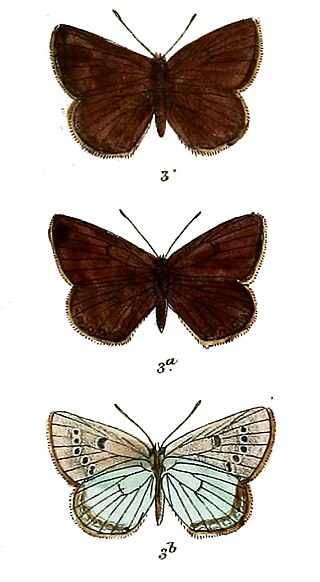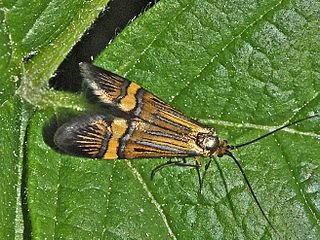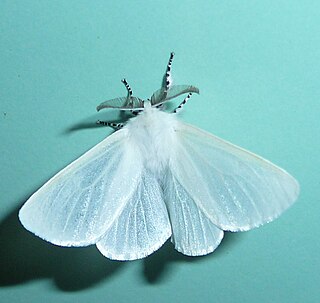
Lampides boeticus, the pea blue, or long-tailed blue, is a small butterfly that belongs to the lycaenids or gossamer-winged family.

Patricius younghusbandi is a species of lycaenid butterfly found in Asia.

Arhopala bazaloides, the Tamil oakblue, is a species of lycaenid or blue butterfly found in Asia. The Tamil oakblue is found India in, Myanmar, Sri Lanka and Thailand.

The longhorn moth or yellow-barred long-horn is a diurnal lepidopteran from the moths family Adelidae.

Biston strataria, the oak beauty, is a moth of the family Geometridae. It is native to Europe, the Balkan countries and the Black Sea region as far as Asia Minor and the Caucasus. The species was first described by Johann Siegfried Hufnagel in 1767. B. strataria is found in a variety of habitats, but is mostly found in woodlands where it rests on the bark of trees, camouflaged by its mottled black and grey wings. The male has feather-like antennae while those of the female are more thread-like. The moth has a wingspan of 40 to 56 mm.

Macaria wauaria, the V-moth, is a moth of the family Geometridae. It has a Holarctic distribution. The species was first described by Carl Linnaeus in his 1758 10th edition of Systema Naturae.

Scopula marginepunctata, the mullein wave, is a moth of the family Geometridae. It was described by Johann August Ephraim Goeze in 1781. It is found throughout Europe.

Nematopogon robertella is a moth of the family Adelidae. It is found in Europe.

Peridea anceps, the great prominent, is a moth of the family Notodontidae first described by Johann August Ephraim Goeze in 1781. It is found in central and southern Europe and North Africa.

Leucoma salicis, the white satin moth or satin moth, is a moth of the family Erebidae. The species was first described by Carl Linnaeus in his 1758 10th edition of Systema Naturae. It is found in Europe including the British Isles but not the far north. In the east it is found across the Palearctic to Japan. Also in North America where it was introduced in the 1920s.

Cleorodes is a monotypic moth genus in the family Geometridae described by Warren in 1894. Its single species, Cleorodes lichenaria, the Brussels lace, was first described by Johann Siegfried Hufnagel in 1767.

Micropterix aglaella is a species of moth belonging to the family Micropterigidae.It is found in southern France, south-western Switzerland and northern Italy.
Clarkeophlebia is an enigmatic and almost-unknown gelechioid moth genus. It contains a single species, Clarkeophlebia argentea, and is apparently endemic to Fatu Hiva in the Marquesas Islands of Polynesia. It was originally described as Acanthophlebia, but this name had earlier been given to a genus of prong-gilled mayflies.

Zygaena lonicerae, the narrow-bordered five-spot burnet, is a moth of the family Zygaenidae. The species was first described by Theodor Gottlieb von Scheven in 1777.

Coleophora anatipennella is a moth of the case-bearer family (Coleophoridae).

Mompha langiella is a moth of the family Momphidae. It is found in most of Europe, except parts of the Balkan Peninsula and the Mediterranean islands.
Nematopogon magna is a moth of the Adelidae family. It is found in Ireland, Great Britain, Denmark, Germany, Switzerland, Austria, Fennoscandia, the Baltic region and northern Russia.
Spanistoneura acrospodia is a moth of the family Tortricidae first described by Alexey Diakonoff in 1982. It is found in Sri Lanka.
Grapholita dysaethria is a moth of the family Tortricidae first described by Alexey Diakonoff in 1982. It is found in Sri Lanka.
Physetica funerea is a species of moth of the family Noctuidae. It is endemic to New Zealand and is found only in the western and central parts of the South Island. This species inhabits shrubland in the subalpine and alpine zones. The life history of this species is unknown as are the larval host species. Adults of this species are on the wing from October to February. This species is almost identical to P. cucullina with the only difference between the two species being the structure of the male antennae. P. funerea is also similar in appearance to P. sequens, but the latter species tends to have a prominently underlined kidney-shaped mark nearer to the outer edge of the forewing.
Content in this edit is translated from the existing Norwegian Wikipedia article at no:Narycia duplicella; see its history for attribution.















